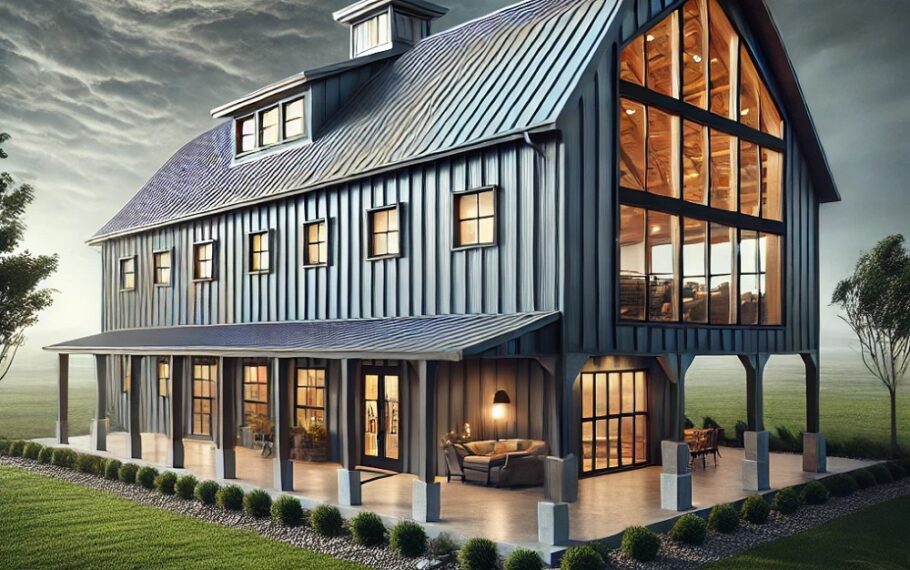As the barndominium trend continues to thrive, homeowners and builders alike are often faced with an important structural decision: Should you choose a post-frame or steel frame construction for your barndominium? Both options offer distinct advantages, but when it comes to strength, resilience, and long-term performance, understanding the key differences between these two systems is crucial.
In this post, we’ll dive into the structural components, performance under stress, durability, and the pros and cons of post-frame and steel frame barndominiums. By the end, you’ll have a clearer idea of which system best suits your needs, especially if strength is your top priority.
What Is a Post-Frame Barndominium?
Post-frame construction, often referred to as “pole barn” construction, is a method that uses large wooden posts or poles as the primary vertical structural supports. These posts are typically embedded directly into the ground or mounted onto concrete piers. Horizontal girts and trusses connect the posts to form the framework of the building. Metal siding and roofing are commonly used to finish the exterior.
Key Features of Post-Frame Construction:
- Large wooden posts placed 8 to 12 feet apart
- Wood trusses and girts
- Foundation can be a slab or pier system
- Metal exterior panels
This system is popular for its simplicity, cost-effectiveness, and ease of construction, particularly in rural or agricultural settings.
What Is a Steel Frame Barndominium?
Steel frame construction involves a skeleton made entirely of steel columns and beams. These frames are usually fabricated off-site and assembled on a concrete slab foundation. Steel frames provide a high level of precision, consistency, and strength, especially in large-span structures.
Key Features of Steel Frame Construction:
- Structural steel columns and beams
- Pre-engineered or custom-fabricated components
- Fully welded or bolted connections
- Typically built on a concrete slab foundation
- Non-combustible materials
Steel frame systems are often favored in commercial and industrial applications but are increasingly being used for residential barndominiums due to their superior strength and durability.
Strength Comparison: Post-Frame vs. Steel Frame
- Load-Bearing Capacity
Steel frames generally have a higher load-bearing capacity compared to wood. Steel’s high tensile and compressive strength allows it to support greater loads with less material. This is especially important in areas with heavy snow, high winds, or other environmental stressors.
Post-frame buildings can still be quite strong, particularly when designed by an experienced engineer. However, wood has natural limitations and can warp, rot, or split over time, especially in humid or pest-prone environments.
- Resistance to Natural Forces
- Wind: Steel frames tend to outperform post-frame buildings in areas prone to high winds, including hurricane zones. The rigidity and tensile strength of steel provide greater resistance to lateral loads.
- Snow Load: Steel is more effective at supporting heavy snow loads, especially in wide-span roofs without internal support columns.
- Seismic Activity: Both systems can be engineered for seismic resistance, but steel’s flexibility and ductility give it an edge in withstanding earthquake forces.
- Fire Resistance
Steel is non-combustible, meaning it will not catch fire or contribute to flame spread. Post-frame structures made from wood are inherently combustible, although fire-retardant treatments can be applied. In high-fire-risk areas, steel offers a clear advantage.
- Pest and Rot Resistance
Wood is susceptible to termites, carpenter ants, and rot if not properly treated and maintained. Steel, being inorganic, is immune to these threats, making it a better choice in regions where pests are a concern.
Longevity and Maintenance
Post-Frame:
- Lifespan depends heavily on material quality and maintenance
- Wood posts in contact with soil may deteriorate over time
- Requires regular inspections and possible treatments for pests and rot
Steel Frame:
- Steel frames can last 50+ years with minimal maintenance
- Corrosion can be an issue, but galvanized or coated steel resists rust
- Maintenance generally includes periodic inspections for rust and bolt tightening
In terms of longevity and lower maintenance demands, steel frames have a notable edge.
Cost Considerations
While post-frame construction is typically less expensive upfront, steel frame barndominiums may offer better value over time due to lower maintenance costs and longer life expectancy.
Post-Frame Pros:
- Lower initial construction cost
- Easier and faster to build with smaller crews
- Wood materials are widely available
Steel Frame Pros:
- Superior strength and stability
- Lower long-term maintenance costs
- Better performance in extreme conditions
The cost difference often depends on regional material availability, labor rates, and the complexity of the design.
Design Flexibility
Steel frames allow for greater design flexibility, especially when it comes to large open interiors without load-bearing walls. This makes steel frame barndominiums ideal for open-concept layouts.
Post-frame systems can also be customized, but they may require additional internal supports for wide open spans, which can limit interior design options.
Which Is Stronger? The Verdict
From a pure strength perspective, steel frame barndominiums are stronger. They outperform post-frame systems in nearly every structural category, including load-bearing capacity, wind and snow resistance, fire safety, and longevity.
However, strength isn’t the only factor to consider. If you live in a mild climate and are looking for a cost-effective, quicker build, a post-frame barndominium may still meet your needs. But if you’re building in a region with extreme weather, high fire risk, or you prioritize long-term durability and minimal maintenance, steel is likely the better investment.
Final Thoughts
Choosing between post-frame and steel frame construction for your barndominium comes down to your specific needs, location, and budget. While post-frame construction remains a solid choice for many rural homeowners, the undeniable strength and resilience of steel frames make them an increasingly popular option for modern barndominiums.
If strength and durability are top priorities in your barndominium project, steel frame construction is the clear winner.
Have questions about designing your barndominium or need help evaluating structural options? Reach out to a professional design service or structural engineer to get expert guidance tailored to your site and goals.

